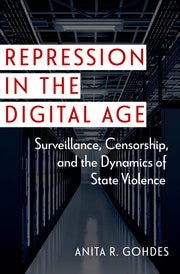Repression in the Digital Age
A new book explores the connections between censorship and violent repression
Anita R. Gohdes, Repression in the Digital Age: Surveillance, Censorship, and the Dynamics of State Violence (Oxford University Press, 2024)
Gaza has been largely cut off from the internet for the last week, as has often been the case during the long months of Israel’s devastatingly destructive war. The series of internet blackouts, combined with the denial of permission for international journalists to independently enter Gaza and Israel’s relentless killing of local Gazan journalists, makes it more difficult for citizen journalists (or anyone else) to transmit pictures and videos of the destruction out to the broader world. It also makes it more difficult for Palestinians outside of Gaza to communicate with those on the inside.
While Israel’s closure of Gaza’s internet is extreme, such internet blackouts have become an increasingly common weapon of war and of autocratic repression. In Sudan, activists warn of internet closures preceding particularly vicious masacres. During the early Arab spring, autocratic regimes like Egypt’s shut down the internet at key moments in an attempt to disrupt protest planning. Ethiopia shut down the Tigray region’s internet access for over two years as part of its horrific crackdown. Russia has disrupted Ukraine’s internet on multiple occasions (that shutdown, unlike Palestine’s, has at least been mitigated by Starlink access).
In her rigorous and fascinating new book Repression in the Digital Age, Anita Gohdes sets out to explore the logic and the effects of internet shutdowns on protest and state violence. This week, Gohdes joined the Middle East Political Science Podcast to talk about the book: listen to our conversation here!
Gohdes frames the connection between the internet and state violence around the question of information. Autocratic regimes can learn a lot about their opposition by allowing a relatively free and open internet. State agents can monitor conversations online, identify leaders and key hubs, learn about upcoming protest events, or find out what topics seem to be gaining negative traction among attentive citizens. With the rise of digital surveillance technology, they can also target potential opposition leaders by hacking phones, getting access to private Twitter conversations, and other nefarious means. For those interested, the POMEPS Studies volume produced in collaboration with Stanford a couple of years ago digs deeply into the means and modalities of digital authoritarianism; I also have a chapter making a similar argument about legibility and state capacity in a book with Steven Heydemann on the Arab state coming out this summer.
Gohdes argues that the advantages of digital surveillance can in many cases outweigh the benefits of repression - in part because they allow for more targeted repression. But, she argues, sometimes protests get too big or risk getting out of hand, at which point autocrats may opt for internet shutdowns. This interferes with activist coordination and messaging, and prevents information about either protest numbers or violent repression from getting out in real time. But it also shuts off valuable sources of information about regime opponents - which, she argues, often leads to indiscriminate violent repression as regimes lash out against all potential opponents. More information can thus facilitate both more protest and more targeted repression; less information can produce greater state violence.
Gohdes investigates these hypotheses with rigorous case analysis of Syria and Iran. It is worth mentioning here that this is not primarily a study of social media (in contrast to a lot of the work that I and my colleagues did in the late lamented Blogs and Bullets series). Gohdes examines the internet at a larger scale, encompassing not just social media but commerce, communications, search, and all the other aspects of digital life. She offers extremely useful technical discussions of how exactly states shut down the interent, why it tends to be for shorter rather than longer periods, and how such shutdowns can be targeted or circumvented. She also goes into detail on exactly how states are able to use internet infrastructure for surveillance and censorship purposes. Shutdowns targeted to particular regions (opposition controlled areas in Syria, Tigray, etc) have different dynamics than full national blackouts, obviously. Shutdowns need to be used with some care, since those that hit ordinary citizens might actually anger them enough to get them out into the streets (as has been argued in the case of Egypt’s 2011 revolution).
For the violence part of her analysis, Gohdes draws on long years of work with HRDAG, where she helped develop robust methods to cross-check and evaluate the reporting of deaths in Syria. The fine grained data allows her to examine whether and how the 13 recorded internet shutdowns during the years of her study of Syria affected both the number of those killed by the regime and their identities. She finds that, indeed, when the internet is taken down, the regime tended to kill more people, more indiscriminately.
Gohdes’ work will only become more relevant in the coming years. Digital technologies and techniques are ever more fully integrated into both the repressive strategy of autocratic regimes — whether or not they manage to go the full China model — and into the tactics of socially-mediated warfare on all sides. Israel’s lengthy interruptions of internet access in Gaza are extreme, but far from unique, and other potential combatants are no doubt taking notes. Israel doesn’t really seem to be able to hide the extent and scale of the physical devastation, given the degree of international attention to the case compared to, say, Tigray or parts of Syria’s war, but the shutdowns certainly seem to affect the speed, quality and spread of information getting out of Gaza’s hellscape.
Check out my conversation with Gohdes here.



